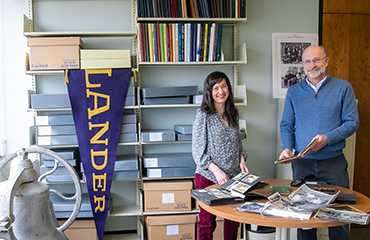
Lisa Wiecki and David Mash of Lander University’s Jackson Library led the research for a new book, “Lander University,” being published for Lander’s Sesquicentennial Celebration. Photo by Laura B. Wood
Is it Hollywood? Or Greenwood?
Photographs of beautiful young women dressed in elegant evening gowns and men wearing tuxedos and white dinner jackets to special events portray a time of glamour in the post-World War II era of Lander University.
More reminiscent of the golden age of Hollywood than life at a small Southern college, the images are among more than 150 photographs in a new 130-page book, “Lander University,” which celebrates Lander’s sesquicentennial. Scheduled for release in mid-April, the book is sponsored by The Lander Foundation and published by Arcadia Press, known for its regional and nostalgic publications.
The book represents over six months of dedicated efforts by Lisa Wiecki, director of Library Services at Jackson Library, and her colleague David Mash, associate director of Library Services. They relied on archival photographs from the early years of Williamston Female College, founded in 1872 in Williamston, S.C., and the forerunner of Lander College (now a university), as well as photographs taken by students and faculty. Scrapbooks donated to the University also have been essential to the project.
“Many of the photographs have never been seen before,” said Wiecki. “David and I found that our days, nights and weekends were consumed by this work. We really learned about the student experience from these donated items.”
She is quick to praise the library’s staff for their commitment to the project. “Our staff worked tirelessly with us to identify images and their context. It was a huge team effort, and truly this is the most enjoyable project I’ve ever worked on,” Wiecki said.
Mike Worley, vice president for University Advancement and executive director of The Lander Foundation, said the book project is a perfect fit for the University’s anniversary year.
“This is an opportunity to share wonderful, but forgotten, chapters of our story with alumni, students and the University’s friends and supporters,” he said. “We are proud of the painstaking effort undertaken to make the book a reality, and we are looking forward to seeing it in print.”
“Lander University” depicts the school’s life and history through the middle of the 20th century, although some photographs portray more recent years on campus. “The book gives us an opportunity to look back and see what a special school this is and what a history we have,” Mash said.
Wiecki added, “This book is visual storytelling, but also includes information from our research.”
One of the most surprising findings was that children served as academic mascots, Wiecki said.
“Beginning in the 1920s and continuing through the 1960s, we found that children were selected as mascots for academic, sporting and other events on campus,” she said. “Children were considered ‘good luck charms’ for the groups that they represented.”
Other findings:
Readers will find the book organized according to Lander’s outline of the different streams of learning – mental, aesthetic, physical and social -- and not by chronological order, Mash said.
“The images in each chapter reflect a specific stream of learning,” he said. “We noticed water themes throughout the school’s early history.”
The presidency of Dr. Boyce M. Grier, 1948 – 66, is highlighted by a focus on student life and the beauty of the era. “Dr. Grier had a keen intuition about the importance of public image,” Wiecki said. “The ‘social stream’ section of the book depicts Dr. Grier’s years at Lander. An energy and excitement were ignited on this campus when he arrived.”
In fact, it was during Grier’s tenure that one Lander student, Miriam Stevenson of Winnsboro, became internationally recognized for her beauty. In the early 1950s, Stevenson was crowned Miss Lander, Miss Greenwood, Miss South Carolina and then Miss South Carolina USA, Miss USA, and ultimately Miss Universe.
“The school was glamorous,” Wiecki said. “It looked like so much fun. Student life seemed to blossom during Dr. Grier’s years at Lander.”
The team found “so many fascinating vignettes” to Lander. “The University has a strong cultural and economic impact on the Greenwood community,” Mash said. “I’m not sure many people today understand how strong that impact has been over the years.”
The people of Greenwood always have been enthusiastic supporters of Lander and were eager to become the home of the college when it was seeking to relocate from Williamston in 1904. “The town acquired the property for the school. They were ‘all in’ when it came to bringing the college to Greenwood,” Mash said. “It was a cooperative effort at every level.”
The nostalgia of “Lander University” highlights that the University’s story isn’t told solely in the passage of years. The story has been written by the people who came to Lander in pursuit of an education.
“The people who attended and those who graduated are part of the lineage of Lander,” Mash said.
That lineage, meticulously researched by library colleagues, will continue through a new generation of Lander University students and alumni.